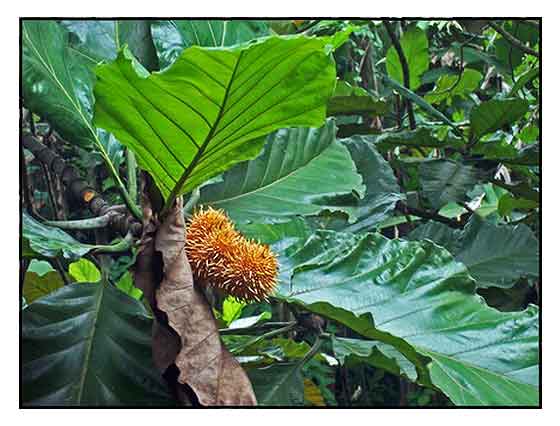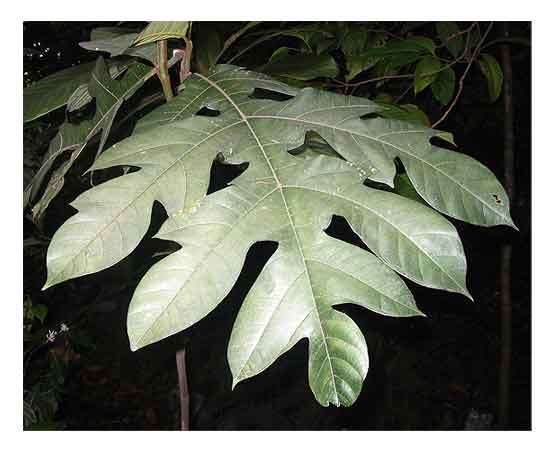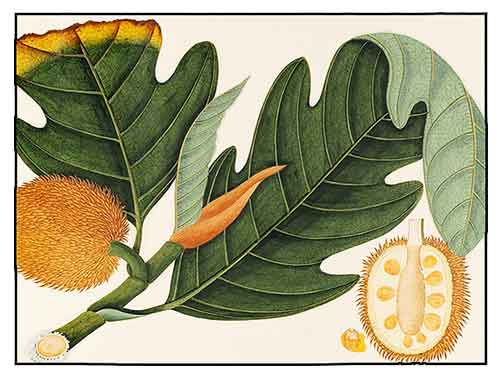 Gen info Gen info
- Artocarpus is a genus of about 60 trees and shrubs of Southeast Asian and Pacific origin, belonging to the mulberry family, Moraceae.
-
Etymology: The genus name Artocarpus derives from Greek words: artos meaning bread and karpos meaning fruit. The species epithet elasticus is Latin, meaning elastic or flexible, referring to the white latex.(3)
Botany
- Artocarpus elasticus is a tree that can grow up to 45 m tall, 90 cm trunk diameter, with buttresses up to 3 m tall. Bark is greyish brown, range from smooth to slightly scaly. Tree produces white sap when wounded. Leaves are spirally arranged, and simple with rough hairs on both upper and lower surfaces. The leaves are dimorphic, where young plant has deeply lobed leaves and adult tree has elliptical to oblong entire leaves, about 15 – 60 cm long and 10 – 35 cm wide. Lateral venation is prominent on the underside of the leaves and petiole is 4 – 10 cm long. Stipule (6 – 20 cm long) is densely covered with yellowish or reddish brown hairs and wraps almost entirely around the stem (amplexicaul), leaving circular stipule scar when dropped. Inflorescences (about 4 – 7.5 cm long) occurs solitary and axillary. Male and female flowers occurs on different individuals. Male flowers have 0.9 mm long stamens and oblong anthers while female flowers have simple or bifid styles which protrude out. Fruit is cylindrical (up to 12 cm long and 6 cm wide), with soft recurved spines. Fruit is cream yellow and ripen brownish with a rancid smell. Seeds are covered in white succulent flesh. (3)
Distribution
- Native to the Philippines.
- Also native to Borneo, Jawa, Lesser Sunda Is., Malaya, Myanmar, Sumatera, Thailand.
(1)
- Grows primarily in the wet tropical biome.
 Constituents Constituents
- Study of bark for α-glucosidase inhibitors yielded dihydrobenzoxanthones (1-4) and alkylated flavones (5-6). Compounds 1 and 5 were named artoindonesianin W and artoflavone B, respectively. (see study below) (5)
- Phytochemical study of bark isolated artonin E (1), a new dihydrobenzoxanthone derivative, elastixanthone (2), cycloartobiloxanthone (3) and artobiloxanthone (4). (see study below) (6)
Study of leaves isolated four new prenylated dihydrochalcones names elastichalcones C, D, E, F (1, 3, 5, 6) together with elastichalcone B (2) and artocarpanone (4). (see study below) (11)
- Study of root bark isolated five new prenylated flavonoids, artelastoheterool (1), artelasticinol (2), cycloartelastoxanthone (3), artelastoxanthone (4) and cycloartelastoxanthendiol (5), along with five known compounds. (see study below) (13)
Properties
- Studies have suggest cytotoxicity, anticancer, neuraminidase inhibitory, neutrophil elastase inhibitory, anti-inflammatory, antidiabetic properties.
Parts used
Roots, leaves, bark, wood.
 Uses Uses
Edibility
-Fruits and seeds are edible.
Folkloric
- In Indonesia, roots and leaves are used in traditional medicine for treatment of inflammation, malarial fever, hypertension, and diabetes.
Others
- Wood: Used for light construction.
- Crafts: Bark used by Sarawak aborigines for making ropes and cloth. Bark is tough and easily strips in large sheets, used by forest natives and Malays for lining baskets and bins, making house-walls and strings. (3) (4)
- Latex: Used for making bird glue for trapping.
- Rituals: In Indonesia, among the Baduy community, leaves of A. elasticus are one of the plants used in traditional rituals: mipit (harvesting rice), swidden farming (slash and burn), upacara (rice offering to ancestor). (18)
Studies
• Inhibition of α-Glucosidase / Dihydrobenzoxantones / Bark: Study of bark for α-glucosidase inhibitors yielded dihydrobenzoxanthones (1-4) and alkylated flavones (5-6). All compounds exhibited significant significant enzyme inhibition toward α-glucosidase with IC50 of 7.6-25.4 µM. Dihydrobenzo-xantones (1-4) exhibited competitive inhibition to α-glucosidase. Compounds 1 and 5 were named artoindonesianin W and artoflavone B, respectively. Results suggest dihydrobenzoxanthone as a lead skeleton of a competitive inhibitor toward α-glucosidase. (5)
• Artonin E / Anti-Breast Cancer / Radical Scavenging / Antimicrobial / Bark: Phytochemical study of bark isolated artonin E (1), a new dihydrobenzoxanthone derivative, elastixanthone (2), cycloartobiloxanthone (3) and artobiloxanthone (4). Compounds 1-3 exhibited outstanding scavenging activity for DPPH with IC50s of 11.5, 21.6, and 40.0 µg/mL, respectively. Compounds 1-3 also displayed broad spectrum antimicrobial activities against 13 bacterial strains using disc diffusion assay. Artonin E exhibited strong cytotoxic activity against human estrogen receptor (ER+) positive breast cancer (MCF-7) and human estrogen receptor (ER-) negative (MDA-MB 231) cells, with IC50s of 2.6 and 13.5 µg/mL, respectively, with no toxicity to WRL68 (human normal liver) cell line. (6)
• Oxepinoflavone / Cytotoxicity against Murine Leukemia P-388 Cells / Wood: Study of wood of A. elasticus isolated a new oxepinoflavone, artoindonesianin E1 (1), along with four known prenylated flavones: artocarpin (2), cycloartocarpin (3), cudraflavones A and C (4,5). Artoindonesianin E1 showed cytotoxic activity against murine leukemia P-388 cells with IC50 of 5.0 µg/mL. (7)
• Anticancer Mechanism of Artonin E: Study focused on a subgroup of compounds designated artonins, with derivative artonin E as a lead anticancer agent. Art-E has shown marked anticancer effects after oral administration in vivo and in vitro. The mechanism of action highlights the functional analogy between Art-E and natural antitumor product morusin. Both compounds trigger TRAIL-mediated apoptosis of cancer cells. (8)
• Antioxidant / Radical Scavenging Activity / Peel: In a study of 15 ethanolic extracts from five Malayan Artocarpus species, a peel extract of A. elasticus exhibited remarkable radical scavenging activity on DPPH, ABTS cation, and superoxide anion, and can be considered a potent antioxidant for use in cosmeceutical products. (9)
• Bacterial Neuraminidase (BNA) Inhibitory Activity / Root Bark: Primary screening of methanol extracts of root bark confirmed potent inhibition of bacterial neuraminidase (BNA), which plays a major role in the pathogenesis of many microbial diseases. Among eight isolates, dihydrobenzoxanthones attained highest BNA inhibition with IC50 of 0.5 ∼ 3.9 µM. Molecular docking suggested the dihydrobenzo-xanthones 4 and 6 as noncompetitive inhibitors of BNA with unique interaction with Tyr435 of BNA in comparison with mother flavonoid (7). (10)
• Antibacterial / Anticancer / Elastichalcones / Leaves: Study of leaves isolated four new prenylated dihydrochalcones names elastichalcones C, D, E, F (1, 3, 5, 6) together with elastichalcone B (2) and artocarpanone (4). Elastichalcone C (1) exhibited good antibacterial activity against Staphylococcus aureus and methicillin-resistant S. aureus SK1, and cytotoxicity against human epidermoid carcinoma (A431) cell lines. (11)
• Silver Nanoparticles / Stem Bark: Study reports on the green synthesis of silver nanoparticles using Artocarpus elasticus stem bark extract as both reductant and stabilizer. (12)
• Cytotoxic Prenylflavonoids / Anticancer against A549 Cell Line / Root Bark: Study of root bark isolated five new prenylated flavonoids, artelastoheterool (1), artelasticinol (2), cycloartelastoxanthone (3), artelastoxanthone (4) and cycloartelastoxanthendiol (5), along with five known compounds. Compound 6, artonol A, exhibited cytotoxic activity against A549 human cancer cell line, with ED50 of 1.1 µg/mL. (13)
• Artonin E / Cytotoxic Mechanisms in Breast Cancer / Stem Bark: Artonin E is a prenylated flavonoid compounds isolated from the stem bark of A. elasticus. Study evaluated the cytotoxic mechanism of Artonin E in MCF-7 breast cancer cells. Artonin E significantly suppressed the breast cancer cell viability while inducing apoptosis in a dose-dependent manner. Apoptosis was caspase dependent, mediated mainly through the intrinsic pathway with elevation of total ROS. There was significant upregulation of cytochrome C, Bax, caspases 7 and 9, and p21, with downregulation of of MAPK and cyclin D. Livin whole upregulation has been noted to precede chemotherapeutic resistance and apoptosis evasion was remarkably suppressed. Results suggest a potential agent in the treatment of breast cancer. (14)
• Artonin E / Apoptosis in Ovarian Cancer Cells / Stem Bark: Study evaluated the apoptotic mechanisms induced by artonin E in a metastatic human ovarian cancer cell line SKOV-3 in vitro. MTT assay showed that artonin E inhibited the growth of SKOV-3 cells, with IC50 of 6.5 ± 0.5 µg/mL after 72 h, and showed less toxicity toward a normal human ovarian cell line T1074, with IC50 32.5. Expression levels of survivin and HSP70 proteins were down regulated in SKOV-3 cells treated with artonin. Artonin E induced an antiproliferative effect via apoptosis and cell cycle arrest at the S phase through dysregulation of mitochondrial pathways, particularly the pro- and anti-apoptosis signaling pathways. (15)
• Human Neutrophil Elastase Inhibition / Dihydrobenzoxanthones / Root Barks: Neutrophil elastases are deposited in azurophiic granules interspace of neutrophils and are associated with inflammatory ailments. A. elasticus has been proven to possess anti-inflammatory activities that might be associated with the HNE enzyme. In primary experiment, the methanol extract of root barks showed significant potential (50 µg/mL, 80% inhibition) against HNE. Chloroform fractions yielded 8 compounds: norartocarpetin (1), artoflavone B (2), KB 2 (3), artonin E (4), artobiloxanthone (5), artoindonesianin W (6), cycloartobiloxanthone (7), and artoindonesianin P (8). All isolated inhibited HNE in a dose-dependent manner, but alkylated flavones 2-4 and dihydrobenzoxanthones 5-8 showed much higher inhibition than the mother skeleton. (16)
• Artonin E / Anticancer Effect in MDA-MB 231 Triple Negative Breast Cancer Cells: Study evaluated the mechanism of inhibition of Artonin E on MDA-MB 231 triple negative breast cancer cell. Artonin E effectively relinquished MDA-MB 231 breast cancer cells of their apoptosis evading capacity. Mode of cell death was apoptosis with defined characteristics. Artonin E induced activation of both extrinsic and intrinsic caspases initiators of apoptosis, enhanced the release of total ROS. Gene expression studies revealed the upregulation of TNF-related apoptosis inducing ligand and proapoptotic genes with down regulation of anti-apoptotic genes and proteins. A G2/M cell cycle arrest was observed and attributed to upregulation of p21 independent of p53 status. Study suggests potential for artonin E to combat aggressive triple negative breast cancer. (17)
• Antidiabetic / α-Glucosidase Inhibitory / Artoindonesianin C / Bark: Column chromatography and bioassay-guided fraction of A. elasticus bark isolated artoindonesianin C, which showed significant α-glucosidase inhibitory activity with IC50 value of 31.88 µg/mL. (19)
• Anticancer / Artelastin / Prenylated Flavonoids / Wood: Study of wood fractions yielded two new prenylated flavonoids: artelastocarpin and carpelastofuran and ethyl 2,4-dihydrobenzoate. Two flavonoids and the prenylated flavonoids artelastin, artelastochromene, artelasticin, arocarpesin, and cyclocommunin isolated earlier were tested for invitro cytotoxicity against three human cancer cell lines. All seven flavonoids showed strong to moderate cytotoxic effect, with artelastin showing the most potent activity. (20)
• Antibacterial / Artonin E / MDR Staphylococcus aureus / Wood: Study evaluated the antibacterial activities of artonin E from A. elasticus and lysicamine from leaves of Phoebe grandis against S. aureus including methicillin-resistant Staphylococcus aureus (MRSA) isolates with MICs less than 4 µg/mL and 8 µg/mL, respectively. Time killing curves revealed rapid death with a decline in viable counts (>3 log10 CFU/mL) of S. aureus. (21)
Availability
Wild-crafted.
Seeds in the cybermarket.
|

![]()




 Constituents
Constituents
